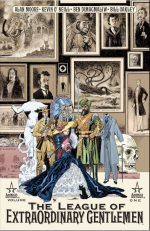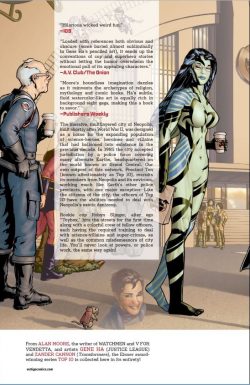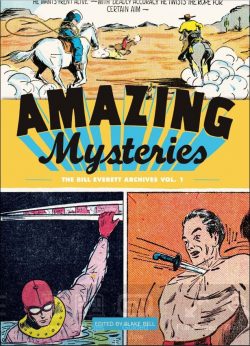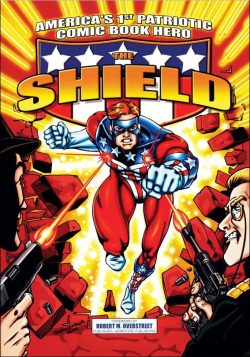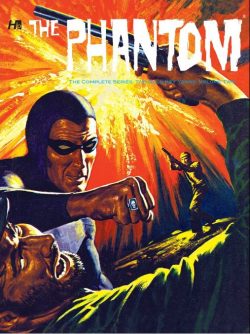
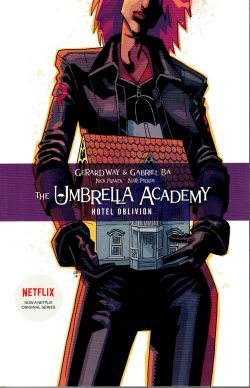
By Gerard Way & Gabriel Bá, with Nick Filardi & Nate Piekos (Dark Horse)
ISBN: 978-1-50671-142-3 (TPB)
Superheroes have been around so long now that they’ve been able to evolve into different sub-sets: straight Save-the-World continuity types as championed by DC and Marvel, obsessively “real†or rationalist iterations such as Marvelman, Crossfire or Kick-Ass, comedic spins like Justice League International or Next Wave and some rare ducks that straddle a few barstools in between.
Addressing the same Edgy, Catastrophic Absurdism as Grant Morrison’s classic Doom Patrol, the archly anti-didactic antics of The Umbrella Academy offered readers a subtly subversive take on the idiom which impressed the heck out of everybody and lured many disillusioned fans back to the pitifully tired and over-used genre when first released. Author creator Gerard Way even parlayed the extraordinary success of the Weird Science heroes into a TV series for the team and built a second creative career steering DC’s outré, off-the-wall Young Animal imprint of alternative heroes…
Now a decade later, a new miniseries has resulted in the long-awaited third collected volume (available in trade paperback and digital formats) and is presented here with an effulgent Introduction from star writer and late-converted fan Jeff LeMire…
Once upon a time a strange event occurred. All across Earth, 43 babies were unexpectedly born as the result of apparent immaculate conceptions – or perhaps some kind of inexplicable parthenogenesis.
The births even surprised the mothers, most of whom discarded, abandoned, sold or arranged adoption of their unexpected, terrifying newborns.
Notorious scientist, entrepreneur and closet extraterrestrial Sir Reginald Hargreeves – inventor of the Levitator, mobile umbrella communicator, Clever Crisp cereal, Televator and a process which enabled chimps to speak – had a secret plan, and he knew these kids would all be special. He thus acquired seven of these miracle babies for an undisclosed purpose, subsequently rearing and training the children to become his private superhero team to enact it.
He was in no way a “good†parent…
The callously experimental family, after a spectacular early career, eventually proved to be unmanageable and the Umbrella Academy – created and trained “to save the World†– sundered in grief and acrimony, but not before poor Ben, Number 6 AKA “The Horrorâ€, pointlessly lost his brave young life and Number 5 “The Boy†took a short trip into the future and never came back…
The surviving members of the utterly dysfunctional superhero team parted but were reunited twenty years later when the news broke that Hargreeves – whose nom de guerre was The Monocle – had died. You shouldn’t believe everything you hear on the news…
In the interim, Number 1 son Luther had become an off-earth defender and pioneer, so hideously damaged by a doomed journey to Mars that to save him, Hargreeves had grafted The Spaceboy‘s head onto the body of a colossal Martian Gorilla.
Poor, neglected Vanya, whose musical gifts Hargreeves deemed utterly useless, became a drop-out and wrote a scandalous tell-all book before becoming a voluntary exile amidst Earth’s lowest dregs. When Number 7 returned she was again rejected by her “family†and summarily seduced by a manic musician who unleashed her true potential and almost destroyed the world with her untapped power…
The Boy returned after 60 years of ranging through the time-stream and materialised in the body of the 10-year old he had been. However, his physical form was frozen and he stopped aging at that moment…
Favourite friend, technologist, housekeeper, actual lifelong care-giver and talking chimp Dr. Pogo had died in Vanya’s – or rather The White Violin‘s – apocalyptic attack which had left Allison (Number 3, The Rumor) with her throat severed, apparently forever deprived of her talent for warping reality with a word…
Diego (Number 2, The Kraken) remained the obsessive scary vigilante psychopath he’d always been but Klaus (Number 4, The Séance) was even weirder than before: a floating, shoeless space-case who talked to the dead and pulled the wings off the laws of physics…
Once upon a time, long ago and whilst still children, the Umbrella Academy saved Washington DC from an animated and extremely angry Lincoln Memorial. They’ve had an odd relationship with American Presidents ever since…
Having saved the entire world from prophesied destruction, the dysfunctional quintet were at a loss and killing time in the rubble of their old home until a fresh crisis boiled over and was cleaned up after The Boy’s hidden sponsors (ruthless chronal cops the Temps Aeternalis) sought to make him fulfil the mission they had originally recruited and rebuilt him for…
Now in the aftermath of the global carnage that generated, the battered survivors recuperate unaware that old ‘Evil’ is manifesting in their midst. Long ago, Hargreeves had taken steps to create the ultimate penitentiary for the violent, vicious, crazy and too-powerful foes of his pet Academy, but now the “guests†of his Hotel Oblivion are successfully checking out…
As The Boy explosively pursues the minion’s of The Perseus Corporation, elsewhere Spaceboy is consulting with aged savant Doctor Zoo. The old duffer is planning a trip into the bizarre region dubbed “Afterspace†in search of a lost legend…
The Séance has fallen very low, trading seedy encounters with dead loved ones for drugs, but when he attempts to scam his biker-thug minders events overtake him just when his old allies leave the universe behind in KMiniature War in a Miniature Home’…
With Hargreeves’ guests loose in the hotel, ‘Violence’ mounts in a range of places and dimensions but the greatest threat comes as the nigh-omnipotent Scientific Man gathers his god-like powers and the deadly Murder Magician secures a televator back to Earth…
Chaos increases exponentially as the Academy heroes battle alone against a host of foes and heir own selfish agendas even as Spaceboy braves ‘The Labyrinth’ and discovers lost legend St. Zero hibernating in
The crisis breaks after The Boy’s current target – Perseus X – infiltrates the hotel to liberate his dad and realises that he’s too late… and that something even more diabolical is ‘Free’…
With a host of monsters and super-creeps like Doctor Terminal, the Mothers of Agony and Medusa ravaging Earth, as well as the quandaries of an imminent attack by a trans-dimensional behemoth and a mysterious wonder baby and its revenant, rampaging mother to deal with, the scattered young comrades grudgingly work together against ‘The Fear You Cannot Speak’ but their late collaboration is all for naught as a new team of empowered players materialise with a shocking revelation in concluding chapter ‘Reunion’.
Sadly, the big reveal is a cosmic cliffhanger so be prepared for some major frustration…
Big on mood, bafflement-by-design and astounding action, this is compelling adventure if you’re fully au fait with the previous books and prepared to give the events your full attention, but Hotel Oblivion is only the beginning of the drama and should not be consumed casually. Trust me, though, it’s going to be worth it in the end…
Accompanying all the meta-real wonderment are a wealth of sketches, character drawings and variant covers by Way and Bá under the broad remit ‘Designing the Umbrella Academy Hotel Oblivion’.
Whilst happily swiping, homaging, sampling and remixing the coolest elements from many and varied comics sources, The Umbrella Academy offers a unique synthesis to achieve its own distinctive originality within the tired confines of the superhero genre. It’s a reading experience no jaded Fights ‘n’ Tights fan should miss.
© 2019 Gerard Way and Gabriel Bá. All rights reserved. The Umbrella Academy™ and all properties are trademarks of Gerard Way and Gabriel Bá.



